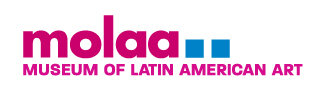Mónica Castillo (Mexico, b. 1951) Plato de Zapata / Zapata’s Dish (detail). 1987. Oil on canvas. 23 3/4 x 48 in. Nicholas Ingram Collection. Photo by Blue Fire courtesy of Teresa Eckmann.
Neomexicanism
MOLAA is proud to present Neomexicanism, an exhibition about a critical tendency in Mexican figurative painting of the 1980s. This groundbreaking exhibition, drawn primarily from the MOLAA Permanent Collection, brings to light a period of art production disenchanted with fixed identities and critical of the official image of Mexicanidad promoted by the state.
Neo-Mexicanism, literally “new Mexicanism” is a critical tendency in Mexican figurative painting of the 1980s. Departing from the cultural movement of the 1930s known as Mexicanism—an attempt to unify the country after the Mexican Revolution—Neo-Mexicanism deconstructs tired and fabricated identities including set gender roles and the exported facade of political and cultural stability in Mexico. At closer glance, Neo-Mexicanism’s folklorish veil is subversive; artists undermine popular icons and transcend nationalist imagery to convey a message of disillusionment in figurative painting and self-portraiture.
New research by art historian Dr. Teresa Eckmann and recent museum exhibitions in San Antonio, Texas and Mexico City have brought to light this irreverent period of Mexican painting disenchanted with fixed identities and critical of the official image of Mexico. Drawn primarily from MOLAA’s Permanent Collection, with additional works on loan from the collection of Nicholas Ingram, the exhibition presents Neo-Mexicanist works collected from the 1980s to the present.
Key Neo-Mexicanist artists Mónica Castillo, Julio Galán, and Nahum B. Zenil are showcased here alongside precursors David Alfaro Siqueiros, Francisco Zúñiga and other artists working after the 1980s who share the aesthetic and thematic currents of Neo-Mexicanism.
Edward Hayes Jr., Assistant Curator
MOLAA would like to acknowledge generous loans from the collection of Nicholas Ingram.

